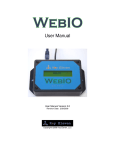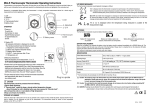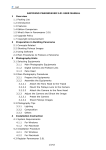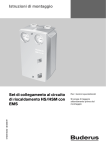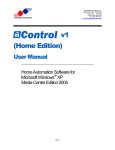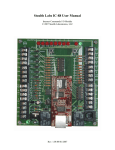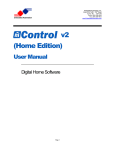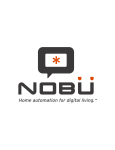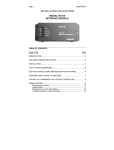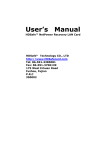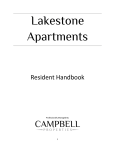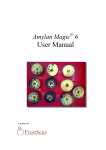Download WebIO User Manual
Transcript
User Manual
Preliminary - User Manual Version 4.0
Addendum to WebIO v2 manual for WebIO v4
Revision Date: 4/28/2010
Copyright2010 Key Eleven, LLC
Table of Contents
Product Information............................................................................................... 3
WebIO Introduction ............................................................................................... 4
WebIO Networking ...................................................................................................................... 5
X10 Modules ............................................................................................................................... 5
WebIO Example Setup ................................................................................................................ 5
WebIO Hardware Setup ........................................................................................ 6
Ethernet Connection.................................................................................................................... 6
X10 Interface ............................................................................................................................... 6
Program Switch ........................................................................................................................... 7
1. Restoring Factory Default Settings .................................................................................... 7
2. Allowing Storage of User Configuration ............................................................................. 7
WebIO Network Setup .......................................................................................... 9
Setting a WebIO IP Address Using a DHCP Server ................................................................... 9
Getting an IP Address from a DHCP server ........................................................................... 9
Locating WebIO on your network using WebIO-KeyOn Software ............................................ 10
Manually Setting the WebIO IP Address Using ARP and Ping ................................................. 12
Setting a Static IP Address (When no DHCP Server is Available) ....................................... 12
Routable Network Setup ..................................................................................... 13
Using WebIO ...................................................................................................... 19
WebIO Functions ....................................................................................................................... 19
Controlling X10 Labeled Devices .............................................................................................. 20
Send X10 Commands ............................................................................................................... 22
Toggle Commands................................................................................................................ 24
Timer ..................................................................................................................................... 25
Passcode .............................................................................................................................. 26
X10 Query Device ................................................................................................................. 26
Sensors ..................................................................................................................................... 27
Sensor Admin ............................................................................................................................ 29
Automation ................................................................................................................................ 31
Admin ........................................................................................................................................ 34
Setting IP Address ................................................................................................................ 36
Setting Date Time ................................................................................................................. 36
Setting A User Passcode ...................................................................................................... 37
WebIO Security ..................................................................................................................... 37
Login .......................................................................................................................................... 39
Edit Device Labels..................................................................................................................... 40
Appendix A ......................................................................................................... 43
WebIO Detailed Manual Network Setup ................................................................................... 43
LAN setup with DHCP: .......................................................................................................... 43
LAN Setup without DHCP: .................................................................................................... 44
Appendix B ......................................................................................................... 45
Limited Warranty ....................................................................................................................... 45
Appendix C ......................................................................................................... 46
Technical Specification.............................................................................................................. 46
Product Information............................................................................................. 48
2
Product Information
This manual is an addendum to WebIO v2 manual. This manual covers added
WebIO features in version 4.0. For “core” WebIO features such as X10 control
and IP address setup, see WebIO Manual version 2.
Owner’s Record
The model number, serial number and MAC address is located on the bottom of
the device. Record the model number, serial number and MAC address in the
space provided below. These numbers are important for user use and
configuration of the Product. Refer to these numbers whenever you call upon
Key Eleven or authorizes service center regarding this product.
Model No. AFX1110
Serial No. ____________
MAC Address ________________
3
WebIO Introduction
WebIO is Internet automation server and gateway, providing both local Ethernet
and remote Internet control of lamps, appliances and other electrical devices and
remote monitor of wireless sensors in the home or office. Utilizing X10 PLC
technology, WebIO sends signals down existing power lines to control X10
compatible PLC devices. WebIO version also includes a wireless sensor
receiver for monitor of wireless entry sensors, motion sensors, sump pump
sensors and more. By containing a built-in web server, WebIO allows remote
users with Internet access to connect to a WebIO via web browser on a computer
laptop or cell phone/Smartphone.
WebIO is built on the idea that an expensive and complex personal computer is
not needed to provide Internet access to an X10 power line control network.
Instead, WebIO is a low cost, small self-contained device that provides all the
functionality of an Ethernet to X10 gateway that is as easy to install as a home
Internet router.
WebIO communicates with X10 modules that support “On”, “Off”, “Query” and
other X10 functions. This includes appliance modules, lamp modules, AC
receptacles, light switches, dry contact modules, relays and many others readily
available devices from suppliers of X10 PLC devices.
WebIO TCP/IP Networking
WebIO provides an RJ45 interface for an Ethernet connection to a local area
network. An IP address may be assigned to a WebIO from a DHCP server or a
static IP address can be set using the WebIO Setup utility software.
For remote monitoring and control, WebIO requires a routable Internet
connection, allowing a user to connect to a WebIO from anywhere in the world
via the Internet.
WebIO network access security is provided via user assignable passcode.
WebIO configuration settings are protected from unauthorized web access via
“program mode” switch located on the WebIO back connection panel. Additional
security requires user supplied VPN device or other network security systems.
4
WebIO Networking
WebIO provides an RJ45 interface for an Ethernet connection to a LAN. An IP
address may be assigned from a DHCP server or a static IP can be set using the
WebIO Setup utility software.
For remote monitoring and control, WebIO requires a routable Internet
connection. This allows a user to connect to a WebIO from anywhere in the
world via the Internet.
X10 Modules
X10 modules plug into AC receptacles providing power to the module and
controlled devices.
The AC power line provides the path for modules to send and receive control
messages. Each X10 module on the AC power line network is addressed with a
House code and Unit code combination. There are 16 House codes assigned a
letter in the range of A-P. Unit codes are assigned numbers 1-16. X10 modules
support different Function codes, such as On, Off, Dim, and State Query.
WebIO Example Setup
The diagram below displays an example setup and operation of the WebIO:
5
WebIO Hardware Setup
WebIO connection panel: (left to right)
Power: 12VDC center pin positive
Program Switch: Place in “Prg” position
when configuring WebIO. Place in
“Lock” position to prevent unwanted
configuration from the Internet.
Expansion port: not used
X10 Port: Connect with 4-pin phone cable
to your X10 transceiver, such as the
PSC05.
Ethernet RJ45: Connect to your Ethernet
network
Rear View of WebIO
Ethernet Connection
WebIO provides an RJ45 jack for Ethernet connection to your Local Area
Network. The left LED of the RJ45 jack will light when the WebIO is correctly
connected to an Ethernet LAN.
X10 Interface
WebIO provides an RJ12 6pin modular interface for connection to an X10
transceiver. When used with a Smart Home PowerLinc II™ X10 transceiver,
power for WebIO is provided by the PowerLinc II.
When used with the PSC05/TW523 X10 transceivers, which do not supply
power, the WebIO barrel connector is used with a 9-12volt dc (center pin
positive) power adapter. Also, an internal WebIO jumper (J6) must be moved
from the left to the right position (nearest barrel connector) to enable the barrel
connector for power. This also disables the RJ12 connector (X10 transceiver
connector) as the power source.
WebIO supports multiple X10 power line transceivers:
The Smart Home PowerLinc II™ serial interface X10 transceiver (with
RJ12 6pin modular connector) in TW523 mode. With this transceiver the
WebIO also receives power, so no extra power supply is needed.
The X10 Pro PSC05 (TW523) transceiver. An additional 9-12 Volt DC,
center pin positive, power supply is required to power the WebIO. Along
with a jumper changed within WebIO.
The PL513/PCS04 transmitter. With the PL513, WebIO can transmit X10
signals but not receive message replies from 2-way X10 modules. In
addition a separate power supply is required for WebIO.
The XM10 transceiver for 230VAC power in UK countries. In addition a
separate power supply is required for WebIO.
6
Program Switch
The Program Switch is located on the rear of a WebIO. This switch is used as a
security device to prevent unauthorized remote users from configuring the
WebIO. To prevent unauthorized or accidental configuration, it is important to
leave this switch in the Lock position.
The Program Switch performs the following functions:
1. Restore factory default settings.
2. Allow storage of user configuration.
3. Display current IP address
1. Restoring Factory Default Settings
To restore WebIO to factory default settings perform the following tasks:
a. Remove power.
b. Switch the Program Switch to the Program (Prg) position (away from
power barrel connector)
c. Reapply power. The WebIO boot process will display the message
"Factory Default".
d. Set the switch back to the Lock position.
Restoring to factory defaults performs three tasks:
1. Removes the user set static IP address. The factory default is to
accept an IP address from a DHCP server.
2. Clears user-set passcode, disabling the use of a passcode until a new
passcode is entered.
3. Clears all user defined X10 device labels.
2. Allowing Storage of User Configuration
Setting the Program Switch to the Prg position while the WebIO is powered
allows the user to perform these tasks:
1. Program a static IP address
2. Set a passcode as described later in this manual.
3. Define labels/names for X10 devices and wireless sensors
WebIO will save these setting to non-volatile memory for recall even if power
is lost and restored.
The function of the Program Switch is also used for security. Remember to
set the Program Switch to the normal (Off/Lock) position after programming
to prevent unauthorized remote users from configuring WebIO.
7
IMPORTANT:
The function of the Program Switch is also used for security.
Remember to set the Program Switch to the normal (Off/Lock)
position after setup programming to prevent unauthorized
remote users from configuring your WebIO.
The Lock position also prevents an accidental Restore to
Factory Defaults on unintentional power cycle of WebIO.
8
WebIO Network Setup
WebIO can operate with either an IP address obtained from a DHCP server, by
using the WebIO Setup utility software, or by using a computers operating
system’s ARP and Ping tools.
Setting a WebIO IP Address Using a DHCP Server
Getting an IP Address from a DHCP server
If WebIO is not configured with an IP address (default setting), WebIO will
then accept an IP address from a DHCP server (A DHCP service in your
home router).
When using DHCP with WebIO, Internet routing to the WebIO may not be
practical in the case where WebIO is power cycled (rebooted) and then
receives a different IP address then previously assigned. Also Routers may
not have the ability to forward to an IP address in the range of the DHCP
assigned address. To avoid this problem when using a router with DHCP
enabled it is best to us a static DHCP service (or Bootp service) where the
DHCP server assigns a defined IP address to the WebIO based on the
WebIO MAC address.
Note: In some rare cases depending on DHCP server used, WebIO may
prioritize DHCP over static, regardless of the WebIO Lock switch position.
Such that if you assign WebIO a static IP address on a network with a DHCP
server, WebIO may accept a new IP address received from the DHCP
server. In some rare cases, in using the WebIO static IP function, you may
need to not have a DHCP server (not so practical) or have the DHCP server
always assign the same IP dependent on MAC address. (Static
DHCP/bootp).
9
Locating WebIO on your network using WebIO-KeyOn Software
When initially installed on a network, WebIO will accept an IP address as assigned by a
DHCP server, such as a DHCP service built into home network routers (Linksys, Netgear,
D-Link, etc). If you do not have DHCP service on your network, see the WebIO user
manual 2.0 for configuring WebIO with an IP address using the WebIO Setup software.
Note: WebIO version 4 does not have an LCD display as does version 2.
Network setup steps:
1. Install and run the WebIO-KeyOn software on a PC computer on the same local
network as WebIO. This software will be used to discover your WebIO’s IP
address as assigned by your DHCP server. See the WebIO-KeyOn manual for
more information on installation and use. Note: There are other ways of finding
WebIO’s IP address, such as looking in your routers connected device list.
Figure 1: WebIO-KeyOn showing your WebIO’s IP address
Note: WebIO-KeyOn PC software is located on the include WebIO CD-ROM. To
install, find and copy directory “WebIO-KeyOn_Vxxx” to your PC, run executable
file: KeyOn.exe in the WebIO-KeyOn folder.
This software is used to configure WebIO, log sensor events and perform email
and text notification.
Note: WebIO-KeyOn, open TCP/IP Port 4041 on your PC for receiving network
messages from WebIO. On first run of this software, Windows operation system
may require your acknowledgement to allow this port to be open.
10
2. Power up WebIO. When WebIO boots is sends out a network message which
WebIO-TM receives to “find” WebIO on the network (See figure 1 above). Also
every time WebIO version 4 receives a wireless sensors message, WebIO will
relay the message on the network for WebIO-TM to receive, this also allows
WebIO-TM to “re-discover” WebIO on the network if needed.
3. Connect to your WebIO using an internet browser. Example. If your WebIO is at
IP address 192.168.1.10 then enter URL address: http://192.168.1.71 into your
computer’s web browser, such as Internet Explorer (IE), Opera, Firefox, etc.
Figure 3: Connection to WebIO (Sensor page) using Internet Explorer web
browser
4. Set WebIO with a Static IP address. This is useful so WebIO’s LAN IP address isn’t
re-assigned an IP address by your routers DHCP service if WebIO is rebooted.
For more information on WebIO IP address and Internet access to WebIO see
“WebIO for Internet Access” at: http://www.webio.us/doc/router-setup.html
To instruct WebIO to store its IP address in Flash memory, see the section
“Using WebIO – Setting an IP address”.
11
Manually Setting the WebIO IP Address Using ARP and Ping
Setting a Static IP Address (When no DHCP Server is Available)
ARP and Ping can be used to set the WebIO IP address. There must not be
a DHCP or BOOTP server on the same network as WebIO when using this
method for setting the IP address.
Windows 9x example:
IP for WebIO: 192.168.1.25
MAC for WebIO: 00-03-75-1f-0c-9f
PC’s IP address: 192.168.1.150
1. Enter the desired IP address for the MAC address of the WebIO into
your PCs ARP table. From a Windows command prompt Enter:
arp –s 192.168.1.25 00-03-75-1f-0c-9f 192.168.1.150
2. Ping the IP address of the WebIO by entering the following command
at a Windows command prompt.
ping 192.168.1.25.
When received, the WebIO will accept this address.
To instruct WebIO to store its IP address in Flash memory, see the section
“Using WebIO – Setting an IP address”.
For more information on setting an IP address see Appendix A.
12
Routable Network Setup
To setup WebIO for remote Internet access, WebIO will need to be assigned
either an Internet IP address, or more commonly, placed behind a router (LAN
side) that has an Internet IP address and is configured to forward via IP port
forwarding to the IP address of the WebIO. This method is referred as “router
port forwarding” and “Network Address Translation” (NAT)
Router Setup (router port forwarding)
Most routers have a feature that allows a user-configuration for port forwarding.
Port forwarding is used to allow an outside request from the Wide Area Network
(WAN) side of the router to be routed to a specific IP address of a device or
computer existing on the inside router network, referred to as the Local Area
Network (LAN).
Message requests sent over a TCP/IP network (such as the Internet) use port
numbers as a way to specify a specific service on a server. For example, a Web
service will listen on port 80 where as an email service on the same server will
listen on port 25. This way a message directed to the server using an IP address
will specify a port number to direct the message to the appropriate service (web
service or e-mail service). As another example, when a web browser asks a web
server for a web page, the browser sends a message to the server, referring to
its IP address and referring to the web services port number on the server. By
default a web browser sends requests to port 80, the default port used by web
servers.
When setting up a router to forward a port to the WebIO, using the default of port
80 is suggested. However the WebIO will accept an HTTP connection on any
port, allowing for router setup in the case that an existing web server on the LAN
side of the router is already assigned to port 80. The WebIO would then need to
be assigned to a different port such as 81 or 8080.
When using a port other than 80, you will need to specify the port number on the
browsers URL using “:” {and port number}. For example to specify port 8081 at
IP address 24.119.179.20, enter: http://24.119.179.20:8081. Or when using a
domain name, enter: http://www.keyeleven.com:8081
13
WebIO Setup for Internet Access
This document describes how to setup WebIO for routable access from the Internet.
WebIO requires a routable internet connection to be accessed from anywhere on the
Internet. WebIO’s built in web page interface can then be accessed from a remote PC
computer or cell phone/Smartphone using a web browser such as Internet Explorer (IE),
Firefox, Opera, etc.
The setup described here creates routable access by configuring a Port Forward in a
Network Router (also known as Network Address Translation (NAT)). This configuration
is just like what can be used for configuring an IP camera, web server or other network
connected device requiring incoming connections from the internet.
A routable connection means that the network device involved (such as a WebIO) can
be connected to (“called”) from a computer or other device that is located on an outside
network such as the Internet. Instead of making a “call/connection” out to a web server
on the internet as does a computers web browser, WebIO requires the ability to be
“called/connected to” from a device on the Internet/another-outside network such as a
computer on a remote network with a connection to the Internet connecting to your
WebIO.
The router involved must have an Internet IP address. A home router will be assigned
an IP address from your Internet Service Provider (ISP). The Router’s Wide Area
Network (WAN) IP address is used to connect to your router from the Internet. A
Router configured with a port forward to your WebIO (forwarding a TCP Port number to
the IP address of your WebIO), will accept a connection from the Internet, and if this
connection requests the port number assigned to your WebIO, the outside/Internet
connection will then be forward to the WebIO connected to the Router’s Local Area
Network (LAN).
Steps to setup WebIO for Internet access:
1. Find your WAN IP address. Your router should display this on its web page
interface.
2. Set an IP address in WebIO (its LAN IP address).
3. Forward a Port in your router to the IP address of your WebIO.
4. Test the connection from a computer with a different Internet connection
Detailed setup instructions (may be different for your router and network
configuration)
1. Figure out your local network address so you can determine an available Static IP
address for WebIO. A network address defines the IP address range available on
your logical network. Example: If a PC connected via Ethernet to your local
network has an IP address of 192.168.1.100 and a subnet mask of 255.255.255.0,
14
2.
3.
4.
5.
then your network address is 192.168.1.0. You would have an address range of
192.168.1.1 through 192.168.1.254. Another common network address for
home networks is 192.168.0.0. You can use the IPCONFIG utility at the windows
command prompt to find your network info.
Set WebIO with a Static IP address. When connecting WebIO to your network, it
may have received an IP address from your Router’s DHCP service, this IP
address can change if WebIO gets rebooted (temporarily looses power). There
are two ways to setup WebIO with a static IP address:
a. (Easiest and preferred method) From WebIO’s “Change IP Address” web
page, set a static IP address (example: 192.168.1.10 for a network
address of 192.168.1.0). In some cases WebIO’s IP address will need to
be outside of your routers DHCP range and in some cases inside,
depending on your router.
b. (Alternate method, if your router supports this) In your router set a static
IP address for the MAC address of your WebIO. Your router will then be
able to identify your WebIO by it’s MAC address and then always give
WebIO the a defined IP address when WebIO boots.
In your router forward a port to your WebIO. TCP/IP uses ports to connect
devices/software together on network(s). WebIO will listen to any port number.
The default port for a web server is 80. 80, 81, 8080, 8081, are good port
numbers for forwarding to WebIO. If you already have a web server, IP camera
or other device using a port such as port 80, then assign WebIO 81, or some
other unused port. Some port numbers may be blocked by your ISP. Sometimes
routers seem to have a bit of trouble getting new configurations to “stick”, or
have “save” buttons that are hard to find, and require a reboot, etc. To forward
an IP address in your Router do these steps:
a. Connect to your router via web browser. Your router may have an IP
address of 192.168.1.1 or 192.168.0.1. Connect via browser by typing in
address: http://192.168.1.1 (for example). Your router may also require
a password login.
b. Find the web page on your router for forwarding a port. This may be
called something other than “forwarding”
c. Create a new forward. Enter TCP port (example 8081). And the local IP
address of your WebIO. (example 192.168.1.10)
d. Save settings.
Find your WAN IP address for your network/router. You can find this in your
router’s web page interface. It’s the Internet IP address assigned to your router
by your ISP. Note: this WAN IP can change depending on your ISP service. In
some cases you can request a static IP or uses DDNS service with your own
domain name.
Now connect to your WebIO from the Internet. From a computer not on your
local network, connect to your WebIO by going to the address: http://{your
WAN IP address}:{port forward to you WebIO}. example:
http://24.116.145.108:8081
15
a. Note, in many cases you can connect to your WebIO from its internet
routable URL address, but in some cases some routers will not “loopback” an internet address back into its own local network.
6. Test connecting to WebIO from a computer on another internet connection
using URL address: http://{your WAN IP address}:{the port number of your
forward} Example: http://24.116.145.108:8087 You should have a friend or
someone on a different internet connection try and connect to your WebIO. If
successful then try and connect using the WAN IP:Port from a computer on your
own network to see if your Router will loopback to your WebIO using the port
forward. Note: If you use port 80, which is a web server’s default port, your
browser will remove “:80” as it’s the default and need not be entered.
a. You can also test from a cell phone with Internet access and a web
browser. Some cell phone browsers don’t work so well. Opera-mini
seems to work well.
b. Note: In many cases you can test your port forward from the LAN side of
your router. From a PC on the same network as WebIO, instead of
entering the WebIO’s LAN IP address for a direct network connection to
WebIO’s web server from your browser, you can use the Router’s WAN IP
and WebIO’s Port as though your connecting from an outside/Internet
connection. Your Router will receive your internal network request and
understand that WebIO is really on its LAN and loop back your request to
WebIO (on the same LAN) using the port you specified. Some routers
don’t support this Loopback.
7. You may want to next get a domain name that points to you WAN IP address so
you can connect my name. example: http://webio.us:8087
16
The diagram above shows the network configuration for making WebIO routable from
the Internet.
17
Above is a screenshot of a NetGear router Port Forwarding configuration. Note
entry #3 for WebIO on Port 8087 forward to LAN IP address 192.168.1.77.
18
Using WebIO
WebIO Functions
WebIO includes an embedded web server, for providing a simple interface to the
user via web browser. This allows for simple operation with no additional
software required to be installed on the user’s PC. The simple web pages of
WebIO even allow for operation from a mobile Smartphone or similar devices
that provide a web browser.
When using a Smartphone with a web browser it become advantageous that
WebIO uses HTML frames allowing the small phone screen size to focus on a
single frame rather than the full web page.
The WebIO web interface provides for:
Controlling X10 devices by label/name
Sending specific X10 commands
Query of an X10 device state
Wireless sensor states
Setting a Static IP address
Setting a User Passcode
Editing device and sensor labels
Reading WebIO temperature
The following sections describe the functions of WebIO.
19
Controlling X10 Labeled Devices
The WebIO web interface provides two methods for controlling X10 Devices.
The Control Devices page (shown below) allows for easy control of X10 On/Off
commands for predefined X10 devices.
The Control Devices page (above) shows a table of predefined X10 Devices.
The On and Off columns contain links for setting the On/Off state of the device in
the selected table row.
When a WebIO passcode is set/enabled, the On/Off links will not trigger X10
commands until the correct passcode is entered in to the Enter Passcode field
and the Unlock button is clicked. After the passcode has been submitted the
Clear passcode when finished link must be selected to re-lock the WebIO from
X10 operations.
20
The Set dim level of last device set on up and down arrow buttons are used to
adjust the dim level of a lamp module that supports X10 dim commands. Only the
last lamp module set on or off will be affected by the dim commands.
The Control Devices web page interface is designed for convenience to the
user for operating several X10 commands with ease. This is accomplished by
using X10 labels, on/off links and a single passcode unlock process.
It is important for the user to understand that the unlock process sets WebIO into
an unlocked state allowing anyone access to sending X10 commands. This is
due to WebIO not having a capability of tracking secure HTTPS sessions with
users as is common with full featured Internet web servers. So it becomes
important to clear the passcode when finished with using the Control Devices
interface to re-lock WebIO from X10 command use.
Also, WebIO will enter locked mode whenever an incorrect passcode is entered
and a passcode is set/enabled.
Also note that X10 Codes web page interface does not set WebIO into an
unlocked state but instead requires the correct passcode to be entered with
every X10 command function when passcode is set/enabled.
IMPORTANT:
When using the Control Devices interface and a WebIO passcode is
set/enabled. The Clear passcode when finished link must be selected
to re-lock WebIO from unauthorized use of X10 command functions.
21
Send X10 Commands
Another method for controlling X10 devices is to use the X10 Codes web page.
This page allows for manually selecting X10 device House code, Unit code, and
the Command to be sent. In addition a timer can be set for when the operation
should occur.
22
To execute an X10 function, select House code, Unit code and Command from
the drop list boxes then set an optional timer and enter Passcode (if enabled)
and click the Execute button.
A table of labeled X10 devices is provided for convenience along with timer and
X10 Query status.
23
WebIO includes support for most of the X10 protocol commands.
WebIO supports sending the following X10 commands
On – Used to turn on a device
Off – Used to turn off a device
Dim – Used to Dim a lamp module
Bright – Used to Brighten a lamp module
All Units Off – Used to turn all modules off of same House
Code
All Lights On – Used to turn all lights on of same House
Code
All Lights Off – Used to turn all lights off of same House
Code
Status Request (Query 2-way device), including receiving
On/Off messages
The following X10 commands are not supported by WebIO.
WebIO does not support the following X10 commands:
Pre-Set Dim High
Pre-Set Dime Low
Extended Data
WebIO adds additional non-X10-protocol commands.
WebIO adds the fallowing X10 functions
On-Wait-Off – Where wait is 4 seconds
Off-Wait-On – Where wait is 4 seconds
Toggle Commands
The WebIO Toggle action is: (on-wait-off) or (off-wait-on) with a 4 second wait
state.
This feature is particularly useful for remotely rebooting Network Routers and
other equipment where remote or local access to WebIO will be briefly
interrupted.
For Example; In case of remotely rebooting a TCP/IP Network Router of which
WebIO is connected, and the Router is connected to an X10 Appliance module:
A WebIO toggle “off/on” command sent to the Routers X10 module, will power off
the router, causing WebIO to be inaccessible via TCP/IP network. Then to
complete the toggle command, WebIO waits 4 seconds and sends an “on”
24
command providing power back to the Router and access to WebIO after the
Router has booted and become operational again.
The Toggle feature is new to WebIO version 1.0.30. WebIO version is displayed
on the LCD as it is powered up.
Note: X10 is not necessarily practical for controlling and maintaining a secure
and reliable environment for network equipment.
Timer
The WebIO X10 command timer is new to version 2.0. This feature allows a
command to be executed at a later time.
Time is configurable in minutes from 1-254. A value of 0 is used to execute a
command immediately. A value of 255 is used to cancel/clear an existing timer
configuration. When using timer value of 255 to clear the timer, the House, Unit
and Command values in the drop down boxes have no effect.
Only one timer exists such that only one X10 command can be configured to be
sent on the configured time.
When a timer is set, WebIO can still be used to execute other X10 commands
with a timer value of 0. If a timer value other then 0 is used, the current timer
configuration will be replaced by the new configuration.
The timer’s time is only accurate to better then +/-2% of set time, such that a
timer set for 60 minutes may occur up to 1 minute and 12 seconds early or late.
Time is effected by WebIO temperature and time can be delayed slightly when
used to execute other X10 commands or functions.
When a timer is set, its status can be viewed at the bottom of the X10 Codes
page. To get an updated minutes remaining status, a page refresh is required.
A message of Not Set is displayed if the timer in not currently set or has
completed.
The timer status is reported as H:{House code} U:{Unit code} C:{Command}
T:{minutes remaining}.
Note: It is not recommended to use the timer function for critical applications, as
X10 is not guaranteed to be reliable such that a person is not in a position to
supervise the X10 action. Also the timer configuration can be lost due to WebIO
losing and regaining power (power cycle). WebIO does not store the timer
configuration in non-volatile memory as WebIO does not have a date-time clock
to know the amount of time passed on power outage. Also WebIO has a
watchdog feature that can cause auto reboot if a problem occurs, though this
should be a very rare event.
25
Passcode
When a WebIO passcode is set/enabled, the passcode must be entered into the
Enter Passcode field before clicking the Execute button. If no passcode or the
incorrect passcode is entered, the WebIO will not execute the selected X10
function. Unlike the Control Devices page, the passcode must be entered for
each command sent.
When no passcode is set/enabled, then this field can be left blank.
WebIO does not report when the incorrect passcode has been entered. This
provides additional security, not allowing an unauthorized user to “discover” the
correct passcode using trial and error.
Also note that X10 Codes web page interface does not set WebIO into an
unlocked state but instead requires the correct passcode to be entered with
every X10 command function when passcode is set/enabled.
X10 Query Device
This feature provides for “asking” an X10 device for its state being “on” or “off” by
using the X10 Status Request command. This feature is useful for validating
that a device is in the expected state after sending an X10 command.
Get X10 device state feature is only supported by X10 devices that can reply to
the Status Request command (often referred to as 2-way X10 devices). This
feature also requires that WebIO be used with a “2-way” X10 Transceiver such
as the Powerlinc or PSC05/TW523.
Note: Some X10 2-way devices seem to be more reliable at receiving
commands then they are at replying to status requests.
WebIO will report a reply from a status request/query as either on or off. If no
status reply is received within 4 seconds. WebIO will report with a No Response
message.
To execute an X10 Query of a 2-way X10 module:
1. Select House code and Unit code of the device to query
2. Select Command “Query”
3. Enter passcode if required
4. Select [Execute] button
5. After a few seconds, select the “Refresh” link on the “Query” status line
near the bottom of the X10 Codes web page.
26
Sensors
The WebIO Sensors web page provides a current overview of up to 8 sensors.
The sensor table shows the sensors assigned to WebIO channels 1-8 including
the sensor ID, its current state and the date time of the last sensor reading.
27
The Sensors web page also shows the activity history of a selected sensor/
channel. This list shows a list of the last 6 sensor states. To make the short list
of 6 states more meaningful WebIO does not store redundant “same” sensor
states, such that a sensor repeating its unchanged state more than 2 times, only
the first state and last state are saved. Some wireless sensors periodically
repeat their current state as a form of “heartbeat” message so demonstrate the
sensor is “still alive” and working. For example if an entry sensor on a door is
open, an Alert message will be received and saved, when the door closes a
Normal message will be received and saved. Over the next several hours the
entry sensor will repeat the Normal Message, where WebIO will only save the
most current Normal message and still retain the first Normal message (after the
door was closed. When the door is opened a second time, an Alert message is
sent and saved by WebIO. In this example WebIO will have stored the First
Alert, the First Normal, and the last normal before the second Alert, and store the
second Alert.
The top of the Sensors web page also displays the current WebIO Security
Mode of Unlocked or Locked. Although this mode is displayed via checkboxes,
the user cannot change the WebIO security mode. The security mode is
changed by using a WebIO registered wireless security remote, where pressing
the “ARM” button places WebIO into Lock mode and the “Disarm” button places
WebIO into Unlock mode. The security mode affects automation on wireless
sensors, such that a sensor going into Alarm state will also trigger a defined
Alarm automation if WebIO is in Lock mode.
To update the current sensor states table and the sensors activity history, select
WebIO sensor channel for refresh and select the [Request Data] button. This will
then send you to the a web page requesting you wait 4 seconds before selecting
a link to return to the Sensors web page. This wait period is due to the time it
takes WebIO to update the sensors tables with the current sensor states.
28
Sensor Admin
The WebIO Sensor Admin web page is used to register up to 8 sensors to the 8
WebIO sensor channels.
WebIO is compatible with many X10 wireless security and automation sensors.
It is important to know the distinction between the two types of sensors. Security
sensors have an internal unique id. This unique ID sometimes changes when
the sensors batteries are replaced, requiring the sensor to be re-registered with
WebIO. Where X10 automation sensors and remotes are addressed using the
standard X10 House/Unit code combination.
To register a sensor with WebIO, you can either use this WebIO web interface or
use the WebIO-KeyOn PC software, which can be a better tool for managing
your sensor network with WebIO.
To register a sensor with WebIO web interface:
1. Activate the sensor
2. Select the [Refresh Sensor Read] Button on the WebIO Sensor Admin
web page. This updates the info below with the value of the last sensor
message received by WebIO. Note: it may be necessary to select this
button a couple times.
3. Note the sensor info provided, where:
29
4.
5.
6.
7.
8.
9.
a. CH: displays the sensors register channel. For an unregistered
sensor this will have the value of 0.
b. ID: displays the sensor’s ID
c. State: displays sensors state as a hex value
d. Time: displays the date time of the reading
Verify that the WebIO received your sensor’s transmission by time of
reading, or if you know the sensors ID (or address for X10 automation
sensors).
Place the WebIO Lock/Program switch into “Prg” position.
Select the channel # to register this sensor to.
Select the [Register Sensor] button.
To verify successful registration, activate the sensor again and goto the
WebIO Sensors web page and refresh the page by using the [Request
Data] button/command. You should now see your sensor in the current
sensor states summary table in the row of the registered channel.
Name your sensor using the WebIO Edit Labels web page.
30
Automation
The WebIO Automation web page is used to assign X10 powerline commands
or Expansion port relay commands to be sent based on wireless sensor states.
Above is the WebIO web page for configuring automation.
31
Note that this internal WebIO automation can also be configured using the
WebIO-KeyOn PC computer software, which provides a more readable user
interface.
Steps to configure an automation for a sensor channel:
1. Under Edit Automation Triggers, select the desired channel number
2. Select the sensor state for this automation. Sensor automation has two
states “Alarm/On/Lock” or “Normal/Off/Unlock”. Entry and motion sensors
use the state terms “Alarm” and “Normal”, where X10 automation remotes
and motion sensors use terms “On” and “Off”, and security remotes use
“Lock” and “Unlock”.
3. Select the X10 module house/unit codes of the device to control
4. Select the X10 module Command (note that command names are
associated with numbers:
a. On = 2
b. Off = 3
c. On-Wait-Off = 21
d. Off-Wait-On = 22
e. Bright Up = 4
f. Dim Down = 5
g. All Units Off = 1
h. All Lights On = 6
i. All Lights Off = 7
j. Query = 15
k. Expansion port Relay state A = 65
l. Expansion port Relay state B = 66
5. Select whether this sensor going into Alert state also triggers the Alarm
automation when WebIO is in Security Lock mode. This Alarm Trigger
flag (AT) is represented by a 1 for true or 0 for false under the “AT”
column.
6. Select the [Update] button. The webpage will return to login page,
navigate back to the Automation page and to verify your update took
place. Also note that the command names only show as numbers.
An automation example: An entry sensor attached to a door is triggered to send
out a wireless “Alert” message when a door opens, WebIO received the wireless
entry sensor message, looks up the sensor channel number in its automation
table and executes a single defined X10 power line command to ring a chime set
to house/unit code A5. A lamp module also set to A5 will turn on as well. Also if
WebIO is in “Security Lock Mode”, and the entry sensors WebIO Channel is
defined to Alarm Lock Mode, the defined alarm X10 command is also executed,
which could be set to ring an alarm, etc. WebIO also sends wireless sensor
message over the TCP/IP Ethernet network to the WebIO-KeyOn software for
further automation and/or Email/Text message automation.
The WebIO Automation web page screenshot above shows that Channel #1
named “Entry 1” is a Security Entry sensor. When this sensor sends an “Alert”
the automation executes X10 A2-On (“On” appears by number “2”). If WebIO is
32
in Security-Lock mode, the Alert Triggers the Alarm automation which is defined
to executes P9-On. Alert Triggers Alarm flag is represented by a “1” under the
“AT” column. When the entry sensor (Channel 1) sends a “Normal” message the
automation executes for X10 M1-Off.
33
Admin
The WebIO, Admin web page provides an interface for:
1. Setting a static IP address to the WebIO non-volatile memory.
2. Setting the Date Time (used for time stamping sensor readings)
3. Configuring a WebIO Passcode
34
To reset the WebIO IP address back to accepting a dynamic IP and to clear the
WebIO passcode and clear the X10 and Sensor Labels, reboot WebIO (cycle
power on and off) with the WebIO Lock-Prg switch in the “Prg” position. See the
section titled “Restoring Factory Default Settings”
35
Setting IP Address
The WebIO, Admin web page provides an interface for saving an IP address to
the WebIO non-volatile memory.
WebIO can be configured to remember a static IP address, even when power is
cycled. This is useful when a DHCP server is not available to assign the WebIO
a dynamic IP address or a specific static IP address, or you do not want to
manually assign an address each time the WebIO is power cycled. Another use
for assigning a static IP address is when a router or other software process
needs to know the WebIO assigned IP address for routing messages or
connecting to WebIO.
To save an IP address:
1. Move the WebIO Program Switch to the program position.
2. From a browser go to the WebIO Admin web page, enter the IP address
and submit the page.
3. Switch the Program Switch back to the Off position to prevent remote
programming and prevent the restoration to factory defaults on reboot.
Note: If you used ARP to set an IP address for the WebIO, the WebIO IP Admin
page may only accept the same IP as in your PC’s ARP table. To assign a
different IP address to WebIO, first clear your ARP table using arp –a. Then
display your ARP table use arp –d {IP address to delete}, to remove an IP
address before using the above procedure to save a different IP address in
WebIO.
Setting Date Time
The WebIO, Admin web page provides an interface for setting the date time of
the WebIO battery backed real-time clock. This time clock is used by WebIO to
date time stamp the receiving of wireless sensor messages. The date time of
sensor messages are stored in WebIO EEProm memory for sensor activity
tables.
To set the date time, Enter the date time in YYMMDDhhmm format using 24 hour
clock. For Example: for 3:42 Pm on April 21, 2010, enter: 1004211542
Although setting the clock uses 24 hour format, WebIO only displays times in the
12 am/pm format.
To Set Date time:
1. Move the WebIO Program Switch to the program position.
2. From a browser go to the WebIO Admin web page, enter the date time in
the YYMMDDhhmm format and select the [Submit] button.
3. Switch the Program Switch back to the Off position to prevent remote
programming and prevent the restoration to factory defaults on reboot.
36
Setting A User Passcode
A WebIO can be configured with a passcode for preventing unauthorized control
of X10 devices. When a passcode is set both the Control Devices and the X10
Codes web pages will require the passcode field to contain the correct
passcode to send an X10 command. When the passcode is incorrect WebIO
gives no indication of invalid passcode and no indication that it did not perform
the X10 command. This provides additional security, not allowing an
unauthorized user to “discover” the correct passcode using trial and error. But
recall that to verify a device state, use the Get X10 Device State web page for
supported X10 2-way devices.
The WebIO, Admin web page provides an interface for saving a passcode to the
WebIO non-volatile memory.
Setting a WebIO Passcode:
1. Move the WebIO Program Switch to the program position (toward the
X10 transceiver connection)
2. From a browser go to the WebIO Admin web page, enter a 4
character alphanumeric (case sensitive) (plus ASCII non-white-space
symbols) passcode and submit the page.
WebIO will only use the first four characters when a passcode of more
than 4 characters are entered.
3. Switch the Program Switch back to the Off position to prevent remote
programming and prevent the restoration to factory defaults on reboot.
When a passcode is set, WebIO will display the passcode on the LCD for 2
seconds on its boot process (when power is applied)(LCD Models of WebIO
only).
Note that a combination of 4 alphanumeric characters plus symbols provides for
over 71 million combinations.
To remove a passcode WebIO must be restored to factory defaults. See the
section titled “Restoring Factory Default Settings”
WebIO Security
The WebIO passcode provides a minimum amount of security. All WebIO
information including the passcode sent from a users web browser to the WebIO
web server is not encrypted, this means that it is possible for someone with the
right tools and knowledge could discover your passcode. For this reason it is not
suggested that a WebIO open to the Internet (Internet routable) be used for
critical applications such as controlling a thermostat.
Even though WebIO doesn’t provide high Internet security, there are methods for
adding high security that are beyond the scope of this manual.
Two examples of a secure WebIO setup:
37
1. A Virtual Private Network (VPN) can be setup that provides an encrypted
tunnel over the Internet between a remote user’s computer or LAN and a
local router of which the WebIO is hiding behind.
2. WebIO can be hidden behind a secure web server, which relays remote
messages to the WebIO.
38
Login
The WebIO, Login web page provides a simple interface to “Unlock” WebIO for
use. To Login, enter your WebIO passcode, select the [Submit] button, after the
page submit, select the “Home” link. On successful login, the home link will now
refresh the WebIO web page with a navigation bar of links to other WebIO pages.
Note: A successful Login “unlocks” WebIO for access to WebIO web pages. This
allows you to refresh current sensor states, but further passcode entry is still
required to execute X10 Commands. The Control Devices web page provides
another “unlock” control for the simple control provided on the Control Devices
page but be sure to select the “clear passcode when finished” link when finished
to re-lock WebIO. The X10 Codes web page requires entry of the passcode
each time an X10 command is executed. This requiring the passcode on each
command to execute is the most secure form of using WebIO as no other user
can submit a command for execution without a passcode. Entry of passcode is
also required each time an Expansion port command is executed.
Note: WebIO passcode Lock and Unlock is not to be confused with the wireless
sensor security WebIO Lock-mode.
39
Edit Device Labels
WebIO provides for the naming of X10 devices and wireless sensors. Rather
than memorizing devices by X10 Address or wireless security sensor ID, a
friendly name can be assigned. In the case of X10 module, a name is assigned
to a House Code and Unit Code and its associated On and Off functions. Eight
X10 devices can be named on the WebIO web interface.
The WebIO, Edit Labels web page interface provides for assigning names to
X10 address to be saved to the WebIO non-volatile memory. Just as with the IP
address and Passcode, X10 labels are protected using the WebIO program
switch.
Assigning Device Labels:
1. Move the WebIO Program Switch to the program position (toward the
X10 transceiver connection)
2. From a browser go to the WebIO Edit Labels page, for each label,
enter Label name and its associated House Code and Unit Code.
This same interface can also be used to edit existing labels.
3. When completed, click-select the Submit button
4. Verify Labels by navigating to the Control X10 Labeled Devices
page.
5. When satisfied, switch the Program Switch back to the Off position to
prevent remote programming and prevent the restoration to factory
defaults on reboot.
When WebIO is restored to factory defaults, all labels are returned to bank with
default House and Unit Codes. See the section titled “Restoring Factory
Default Settings”
WebIO device labels can also be configured using the WebIO Setup utility
software. See WebIO Setup software manual.
40
Shown above is the Edit Labels web page interface for X10 Modules.
Note that edit of X10 labels and Sensor labels can also be performed by the
WebIO-KeyOn PC computer software for WebIO v4 or the WebIO-TM software
for WebIO version 3.
41
Above: The Edit Labels web page also provides an interface for naming
wireless sensor channels.
42
Appendix A
WebIO Detailed Manual Network Setup
LAN setup with DHCP:
1. Connect WebIO to a 10/100BT hub or switch. The left green LED of the
WebIO RJ45 jack will light when correctly connected.
2. After about 5 seconds the WebIO will indicate its IP address. An IP
address of 0.0.0.0 indicates the WebIO had not yet received and IP
address for the DHCP server. It can take a minute or more for the WebIO
to receive and IP address.
3. Change the position of the Program Switch to update the display with the
current IP address. After receiving an IP address, the program switch
should be set in the normal (off) position to prevent reset to factory default
if rebooted and to lock out unauthorized remote programming.
4. Connect to the WebIO using a web browser. Connect to the URL of the
WebIO by manually typing its IP address: http://{IP address}
For example: http://192.168.1.100
5. A successful connection will display the main WebIO page.
6. At this time you may choose to set a Static IP (see instructions: Setting
Static IP Address). Without a Static IP, upon reboot of the WebIO it may
receive a different DHCP assigned IP address.
Note: In some rare cases depending on DHCP server used, WebIO may
prioritize DHCP over static, regardless of the WebIO Lock switch position.
Such that if you assign WebIO a static IP address on a network with a DHCP
server, WebIO may accept a new IP address received from the DHCP
server. In some rare cases, in using the WebIO static IP function, you may
need to not have a DHCP server (not so practical) or have the DHCP server
always assign the same IP dependent on MAC address. (Static
DHCP/bootp).
43
LAN Setup without DHCP:
1. This setup requires the use of ARP and Ping. A DHCP or BOOTP server
must not be present as these will interfere with an ARP command. If
either a DHCP or BOOTP server exists, connect the WebIO using a
crossover cable to a PC.
2. Connect WebIO to a 10/100BT hub or switch. The left green LED of the
WebIO RJ45 jack will light when correctly connected.
3. Use ARP and Ping to assign an IP address to the WebIO. From a PC
running Windows, open a command window.
a. Obtain your IP address:
i. Under Window9x, Enter: ipconfig
ii. Linux, Enter: ifconfig
b. Enter the IP address and MAC address of the WebIO into your
ARP table: arp –s {WebIO IP address} {WebIO MAC address}
{your PC IP address}.
i. Windows 9x Example:
arp –s 192.168.1.101 00-aa-00-62-c6-01 192.168.1.10
ii. Linux Example:
arp –s 192.168.1.101 00:aa:00:62:c6:01 192.168.1.10
c. Assign the IP address to the WebIO, Enter: ping {WebIO IP
address},
i. Example: ping 192.168.1.100
d. If the ping receives a reply, then the WebIO has received the IP
address. If no reply is received, see Troubleshooting - Assigning IP
address using ARP and Ping.
4. Verify that the WebIO has received the IP Address (ensure the reply is not
from another device). Change the position of the Program Switch to
update the display with the current IP address. The Assigned IP address
should be displayed.
5. Connect to the WebIO using a web browser. Connect to URL: http://{IP
address} for example: http://192.168.1.100
6. A successful connection will display the main WebIO page.
7. At this time you should assign a Static IP address (see instructions:
Setting Static IP Address). Without a Static IP, upon reboot of the WebIO
it will look for a DHCP server or default to IP 0.0.0.0.
8. If using a crossover cable, the WebIO can now be plugged into the LAN
with no need to power down.
44
Appendix B
Limited Warranty
Key Eleven, LLC. Warrants this Product (not including any accessories) against defects in
material or workmanship as follows:
Labor and Parts: For a period of 60 day from the date of purchase, if this Product is determined to
be defective, Key Eleven will repair or replace the Product, at its option, at no charge, or pay the
labor charges to any Key Eleven authorized service facility. After the Warranty Period, you must
pay for all labor charges.
To obtain warranty service, you must take the Product, or deliver the Product freight prepaid, in
either its original packaging or packaging affording an equal degree of protection, to Key Eleven
at your expense.
This warranty does not cover customer instruction, installation, set up adjustments or signal
reception problems.
This warranty does not cover cosmetic damage or damage due to acts or God, accident, misuse,
abuse, negligence, commercial use, or modification of, or to any part of the Product. This
warranty does not cover damage due to improper operation or maintenance, connection to
improper voltage supply, or attempted repair by anyone other than a facility authorized by Key
Eleven to service the Product. This warranty does not cover Products sold AS IS or WITH ALL
FAULTS, or consumables (such as fuses or batteries). This warranty is valid only in the United
States.
Proof of purchase in the form of a bill or sale or receipted invoice which is evidence that the unit is
within the Warranty period must be presented to obtain warranty service.
Repair or replacement as provided under this warranty is the exclusive remedy of the consumer.
Key Eleven shall not be liable for any incidental or consequential damages for breach of any
express or implied warranty on this product. Except to the extent prohibited by applicable law, any
implied warranty of merchantability or fitness for a particular purpose on this product is limited in
duration to the duration of this warranty.
In no event shall Key Eleven be liable for special, incidental, consequential or other damages
resulting from the possession or use of this product, including without limitation damage to
property and, to the extent permitted by law, personal injury, even if Key Eleven knew or should
have known of the possibility of such damages.
Some states do not allow the exclusion of limitation of incidental or consequential damages, or
allow limitations on how long an implied warranty lasts, so the above limitations or exclusions
may not apply to you. In addition, if you enter into a service contract with Key Eleven within 60
days of the date of sale, the limitation on how long an implied warranty lasts does not apply to
you. This warranty gives you specific legal rights, and you may have other rights which vary from
state to state.
45
Appendix C
Technical Specification
Technical Features
Built in web interface for X10 power line control and WebIO configuration
LCD display for indication of IP address, configuration messages and user
messages
DHCP client for easy Ethernet network installation - Static IP address
settings when DHCP is not available
Supports X10 power line “on”, “off” and “query” commands
Supports popular X10 power line transceivers (Powerlinc and TW523)
No computer required, WebIO is a total power line control system and web
server in a box
Very low cost embedded systems design based on two 8-bit
microcontrollers
No operating system, true micro code for reliable functionality and rapid
boot process
WebIO configuration is secured via a physical “program mode” switch to
prevent unauthorized configuration via web interface
Hardware watchdog for insured uptime
Specifications
Model Number
AFX1110
Ports
1 RJ45 10 Megabit Ethernet
1 serial ports for PLC transceiver
Storage
EEPROM for configuration storage of IP address and security key
Expansion ports
Internal GPIO lines
Indicators
LCD interface for power, IP address,
Communication activity and Gateway status
LED Ethernet status indicators
Power Line Controller
Supports the SmartHome X10 PowerLinc
Also supports the X10 TW523 (requires 9-12VDC power, center tap
positive (+) at the 2mm barrel connector)
Environmental
Dimensions
1-7/16" x5-1/4" x3" (HxWxD)
Unit Weight
6.0 oz.
Enclosure
Plastic enclosure with mounting holes
Power
Input 9-12VDC
Power consumption 64mA at 12VDC
Sleep mode as low as 34mA, 12VDC
46
Power Supply
(included)
Input: AC120V~
Output: DC12V 250mA
Certifications
WebIO is in compliance with the electromagnetic compatibility
requirements defined in FCC Part 15 Subpart B.
And Canada ICES-003, Issue 4:2004 Class B.
Operating Temp.
0° to +50°C, (limitations due to LCD display)
Storage Temp.
-10° to +60°C, (limitations due to LCD display)
RoHS
Not RoHS compliant
47
Product Information
For more information and software updates, visit the WebIO web site:
http://www.webio.us
http://www.keyeleven.com
or contact:
Key Eleven
1322 11th Street South
Moorhead, MN 56560 USA
Copyright2008 Key Eleven, LLC
Windows is a registered trademark of Microsoft Corporation
48
















































